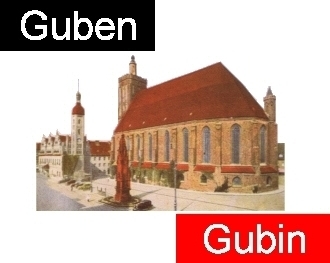110 years ago, on 30 October 1898, the two-emperor monument to Wilhelm I and Friedrich III, his eldest son, was inaugurated in Guben on the market square in front of the town and main church. It was a moving day with an extensive procession and festive speeches.
Such events were not rare in the Empire.
Think of the Victory Column in Berlin (1873),
the German Corner in Koblenz (1897),
the Monument to the Battle of the Nations in Leipzig (1913) or
the Bismarck Tower in Guben (1908).
The Guben monument, designed as a fountain, was created by the Berlin architect Paul Krieschke and had a total height of 18.6 metres.
The materials used were granite from the Fichtelgebirge, polishable syenite (deep rock), red Main sandstone and various metals for the figural design.
After 1935, the plant was demolished again.
The occasion for the erection was the 10th anniversary of the deaths of Wilhelm I, co-founder of the German Empire in 1871, and his son Friedrich III, who had succumbed to cancer in the same year, 1888. At the same time,
Wilhelm II, who was only 29 years old, ascended the throne, so that the term „Three Emperors‘ Year“ was to go down in German history.

Two Emperors Monument in front of the Town and Main Church
Image: Collection Förderverein
The day of the inauguration was described in detail by the „Gubener Zeitung“ in an eight-column article, introduced by a poem by the wealthy lyricist Ernst von Wildenbruch about „Germany’s great time“, marked by „kings and heroes“. Accordingly, the procession, which moved from Bahnhofstrasse (now Berliner Strasse) to the market square, was led by 46 warrior associations from the city and the country. They were followed by the shooting clubs, the upper classes of the grammar school and then the Liederkranz, Harmonie, Germania, Gesangsverein Sprucke, Deutsche Eiche and Borussia singing clubs. Also represented were the craft guilds from the bakers to the shoemakers, other Guben associations and finally the miners in their picturesque traditional costumes.
The ceremonial opening was performed by the head priest of Guben, D. Werner, who was followed by the speech of the former district administrator Prince Heinrich zu Schoenaich-Carolath. He recalled the battles of Königgraetz, Spichern, Metz and Sedan, the return of Alsace-Lorraine and spoke of „what German bravery, German loyalty to duty and joyful devotion to the death are capable of“.
The reader of today hears with dismay the tones of Germanism and nationalism that were to fatefully determine the fate of the German people in 1914 and after 1933. However, no one could have guessed that after a sacrificial First World War a Second would follow, waged by Hitler’s Germany as a war of race and extermination, the consequences of which also left deep traces in Guben.
Whoever stands on the market square in Gubin today may remember a little of this.
Quelle:
von Gerhard Gunia
aus der Lausitzer Rundschau, vom 30. Oktober 2008
WIR SUCHEN STÄNDIG
Fotos, Negative, Zeichnungen, Urkunden, Dokumente, Filme, Zeitzeugen, Unterstützer, Aktive

